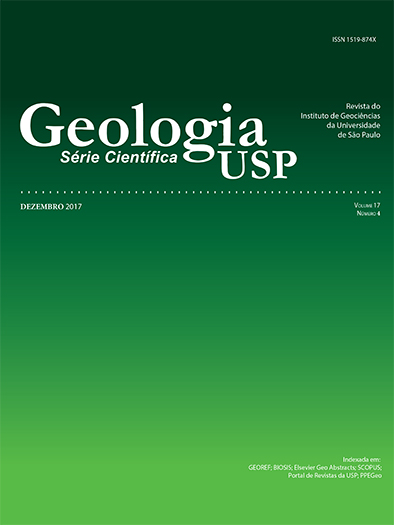Geology, mineralogy, fluid inclusions and genesis of titanite-epidote deposits from Capelinha, Minas Gerais
DOI:
https://doi.org/10.11606/issn.2316-9095.v17-124587Keywords:
Titanite, Epidote, Capelinha County, Minas Gerais State.Abstract
Near Capelinha town, Minas Gerais State, Brazil, titanite-epidote deposits occur associated with pegmatoid veins rich in albite and/or adularia, around two main distinct sites known as Campo do Boa and Fanadinho. These deposits are hosted by a titaniumrich, metavolcanic basic schist, mainly composed by albite, epidote, actinolite, titanite and quartz, of Tonian age. This rock protholite has been identified as an alkali-basalt, metamorphosed at amphibolite facies. These veins present thickness which varies from decimeters to about 4 m, and they are mainly composed by albite, which is partial to entirely kaolinized in the Fanadinho area, where they are also richer in epidote. Quartz is rare, and micas are absent. X-ray diffraction, X-ray fluorescence, electronic microprobe analyses, and fluid inclusions studies allowed to characterize titanite and the main associated minerals in the deposits. Titanite and more rarely epidote can form exceptional druses, very appreciated by mineral collectors, with monocrystals commonly twined and reaching few centimeters along the “c” axis. Apatite, ilmenite and actinolite, though unusual, are other important minerals in these veins. Fluid inclusions studies indicated a minimum crystallization temperature in the range of 300 to 450ºC. Mineralization is genetically related, firstly, to the extrusion of titanium-rich basalts, which have been metamorphosed during the Brasiliano Cycle (± 570 Ma), probably associated with titanite growth and enrichment. Minimum temperatures found for fluid inclusions trapping are completely compatible with amphibolite facies conditions. These data indicate that hydrothermal mineralizing fluids percolated surrounding rocks still during the metamorphism process , probably at its final stage.
Downloads
Downloads
Published
Issue
Section
License
Authors who publish in this journal shall comply with the following terms:
- Authors keep their copyright and grant to Geologia USP: Série Científica the right of first publication, with the paper under the Creative Commons BY-NC-SA license (summary of the license: https://creativecommons.org/licenses/by-nc-sa/4.0 | full text of the license: https://creativecommons.org/licenses/by-nc-sa/4.0/legalcode) that allows the non-commercial sharing of the paper and granting the proper copyrights of the first publication in this journal.
- Authors are authorized to take additional contracts separately, for non-exclusive distribution of the version of the paper published in this journal (publish in institutional repository or as a book chapter), granting the proper copyrights of first publication in this journal.
- Authors are allowed and encouraged to publish and distribute their paper online (in institutional repositories or their personal page) at any point before or during the editorial process, since this can generate productive changes as well as increase the impact and citation of the published paper (See The effect of Open Access and downloads on citation impact).





